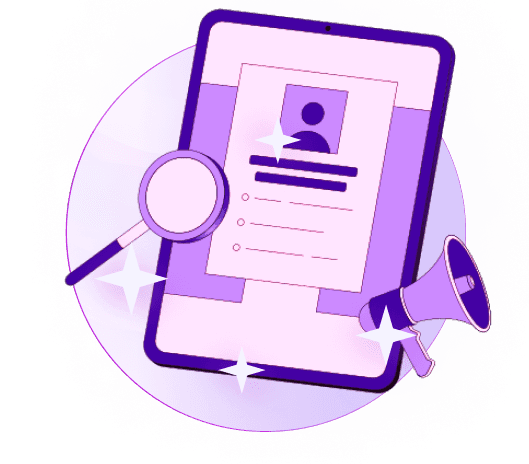Blogs
Articles

The Ultimate Guide to Identifying Decision Makers in B2B Sales
In the dynamic realm of business-to-business sales, the ability to pinpoint key individuals who wield decision-making authority can make or break a deal. This comprehensive guide serves as a strategic roadmap for sales professionals seeking to navigate the intricate world of B2B transactions.
By exploring a range of proven strategies, tactics, and industry insights, this resource empowers sales teams to efficiently connect with the pivotal figures crucial for deal closures. From unraveling organizational hierarchies to harnessing networking platforms, the guide offers a holistic approach to mastering the art of identifying decision makers. By honing this skill, sales experts can streamline their sales pipelines, enhance success rates, and drive sustainable business expansion.
Whether you are a seasoned professional refining your sales arsenal or a novice eager to delve into B2B intricacies, this guide is your indispensable companion for unlocking new opportunities in the competitive world of B2B sales.
Strategies for Effective Identification
The ability to effectively identify key decision-makers and stakeholders is crucial for success. This blog section will delve into strategies that can be employed to enhance this identification process, with a specific focus on utilizing data analytics and implementing networking and relationship building techniques.
Utilizing Data Analytics for Decision Maker Profiling
Data analytics plays a vital role in modern business operations, offering valuable insights that can be leveraged for decision maker profiling. By analyzing data related to customer interactions, purchasing behavior, and market trends, businesses can create detailed profiles of key decision-makers within target organizations. These profiles can include information such as job titles, responsibilities, preferences, and communication styles, enabling more personalized and targeted engagement strategies.
Networking and Relationship Building Techniques
In addition to data analytics, networking and relationship building are essential components of effective identification strategies. Building strong relationships with key decision-makers requires a proactive approach that involves attending industry events, engaging with professional networks, and fostering genuine connections. By establishing trust and credibility through consistent communication and value-driven interactions, businesses can position themselves as trusted partners and increase their chances of securing valuable opportunities.
Enhancing Identification through Personalization
Personalization is a key aspect of effective identification strategies. By tailoring interactions and communications to the specific preferences and needs of decision-makers, businesses can significantly increase engagement and build stronger connections. Utilizing customer relationship management (CRM) systems and marketing automation tools can aid in personalizing interactions at scale, ensuring that each touchpoint resonates with decision-makers on an individual level.
Utilizing Social Media for Identification
Social media platforms offer valuable insights for identifying key decision-makers and understanding their interests and activities. By monitoring social media channels and engaging with decision-makers through these platforms, businesses can gather relevant information that can inform their targeting strategies. Additionally, leveraging social selling techniques can help in establishing rapport and initiating meaningful conversations with key stakeholders.
Effective identification of key decision-makers requires a comprehensive approach that integrates data analytics, networking, relationship building, personalization, and social media engagement. By adopting a holistic strategy that encompasses these elements, businesses can enhance their targeting efforts, forge stronger connections, and drive sustainable growth and success in today's competitive landscape.
Engaging with Decision Makers
When engaging with decision makers, it is crucial to craft tailored messages and proposals that resonate with their specific needs and priorities. By understanding their pain points and aspirations, you can tailor your communication to address these effectively. Additionally, establishing trust and rapport is essential in building a strong relationship. This can be achieved through active listening, demonstrating expertise, and showcasing past successes. Decision makers are more likely to engage with individuals and proposals they trust, making it a key aspect of successful interactions.
Understanding the Decision-Making Process
In order to effectively engage with decision makers, it is vital to comprehend the decision-making process within their organization. Different decision makers may have varying levels of authority and influence, so it is important to identify key stakeholders and decision influencers. By mapping out the decision-making hierarchy, you can tailor your approach to resonate with each individual's role and responsibilities.
Building Credibility and Expertise
Another critical aspect of engaging with decision makers is to establish your credibility and expertise in the relevant field. This can be achieved by showcasing industry knowledge, relevant experience, and successful case studies. Decision makers are more inclined to trust individuals who demonstrate a deep understanding of their industry challenges and offer viable solutions.
Effective Communication Strategies
Successful engagement with decision makers also hinges on employing effective communication strategies. This includes using clear and concise language, focusing on the value proposition, and highlighting the benefits of collaborating or investing in your proposals. Moreover, leveraging data-driven insights and incorporating visual aids can enhance the persuasiveness of your messages.
Sustaining Long-Term Relationships
Lastly, sustaining long-term relationships with decision makers requires ongoing communication, follow-ups on previous discussions, and a commitment to delivering on promises. By nurturing these relationships, you can position yourself as a trusted partner and increase the likelihood of future collaborations and opportunities.
Engaging with decision makers demands a strategic and tailored approach that prioritizes understanding their needs, building trust, and delivering value through effective communication and relationship-building efforts.
Expanding Your Network
In addition to crafting tailored messages and understanding decision-making processes, expanding your network can significantly enhance your opportunities to engage with decision makers. Attending industry events, conferences, and networking gatherings can provide valuable opportunities to meet key decision makers outside formal settings. Building a strong professional network not only increases your visibility but also opens doors to new connections and potential collaborations.
Staying Updated on Industry Trends
To further strengthen your engagement with decision makers, it is essential to stay informed about the latest industry trends, innovations, and challenges. Decision makers appreciate individuals who can offer insights and solutions that align with current market dynamics. By staying updated, you can position yourself as a knowledgeable and forward-thinking professional, earning the respect and interest of decision makers.
Adapting to Different Communication Styles
Each decision maker may have a unique communication style and preference. Adapting your approach to align with their preferred mode of communication can significantly enhance the effectiveness of your interactions. Some decision makers may prefer detailed reports and data analysis, while others may respond better to visual presentations or informal discussions. By understanding and adapting to diverse communication styles, you can tailor your messages for maximum impact and engagement.
Measuring and Evaluating Engagement
To gauge the success of your engagement efforts with decision makers, it is important to establish metrics and evaluation criteria. Tracking the response rates to your communications, monitoring the progression of discussions, and soliciting feedback can provide valuable insights into the effectiveness of your strategies. By analyzing the outcomes of your interactions, you can identify areas for improvement and refine your approach for future engagements.
Emphasizing Sustainable Partnerships
While initial engagements with decision makers are crucial, the focus should also be on fostering sustainable partnerships for long-term collaboration. Building relationships based on mutual trust, shared values, and a commitment to mutual growth can lead to enduring partnerships that benefit all parties involved. Emphasizing the long-term value of the relationship and consistently delivering on promises can solidify your position as a trusted partner in the eyes of decision makers.
In essence, engaging with decision makers requires a multifaceted approach that combines tailored messaging, strategic networking, continuous learning, adaptability, and a focus on building sustainable partnerships. By investing time and effort into understanding decision makers' needs and preferences, demonstrating expertise and reliability, and fostering genuine connections, you can navigate the complexities of decision-making processes and create meaningful opportunities for collaboration and growth.
Overcoming Challenges in Identifying Decision Makers
Dealing with Gatekeepers and Influencers
Navigating through the layers of gatekeepers and influencers within an organization is a common challenge faced by many seeking to identify decision-makers. Gatekeepers act as the first line of defense, controlling access to those in power. Understanding how to interact with them effectively and build relationships can significantly impact your ability to reach decision-makers. In this section, we will discuss practical tips and strategies for handling gatekeepers with diplomacy and skill.
Importance of Building Rapport
Building rapport with gatekeepers is essential in gaining their cooperation. By demonstrating respect for their role and responsibilities, you can establish a foundation of trust that may open doors to decision-makers. Acknowledge the value they bring to the organization and show genuine interest in their insights. This approach can turn gatekeepers into allies rather than obstacles.
Communication Strategies
Effective communication is key when dealing with gatekeepers. Tailor your messages to resonate with their priorities and objectives. Clearly articulate how your proposal or request aligns with the organization's goals and benefits its operations. By speaking their language and highlighting mutual interests, you can increase the likelihood of garnering their support.
Strategies for Penetrating Complex Organizational Structures
Complex organizational structures can often obscure the path to decision-makers, leading to wasted time and effort. To overcome this hurdle, it is crucial to deploy the right strategies. From utilizing organizational charts and networking within the company to leveraging technology for data analysis, there are various approaches that can streamline the process of identifying key decision-makers. This segment will delve deeper into these strategies, providing actionable insights on how to navigate through intricate corporate hierarchies with precision and efficiency.
Leveraging Technology and Analytics
Technology plays a vital role in deciphering complex organizational structures. By harnessing data analytics tools and software solutions, you can uncover hidden connections and relationships within the company. Utilize predictive analytics to identify potential decision-makers based on past behavior and organizational patterns. This data-driven approach can enhance your targeting strategy and improve the accuracy of your outreach efforts.
Cross-Functional Collaboration
Breaking silos and fostering cross-functional collaboration can also facilitate the identification of decision-makers. Engage with colleagues from different departments and levels of the organization to gain diverse perspectives and insights. By pooling resources and knowledge, you can collectively navigate through the organizational maze and pinpoint the individuals with the authority to make key decisions. Emphasize the importance of teamwork and information sharing in achieving a comprehensive understanding of the organizational landscape.
With a combination of interpersonal skills, strategic planning, and technological tools, overcoming challenges in identifying decision-makers becomes a manageable task. By recognizing the significance of gatekeepers, influencers, and organizational structures, you can devise an effective approach that maximizes your chances of reaching the right individuals and securing valuable opportunities.
Conclusion
Identifying decision makers in B2B sales is crucial for the success of any sales strategy. By utilizing a combination of research, networking, and effective communication, sales professionals can navigate the complex organizational structures of businesses to reach key decision makers.
Understanding the roles and responsibilities of individuals within a company allows for targeted and tailored approaches, increasing the likelihood of securing successful sales deals. Remember, persistence and adaptability are key traits when it comes to identifying decision makers in the ever-evolving landscape of B2B sales.

Create Your Free Persana Account Today
Join 5000+ GTM leaders who are using Persana for their outbound needs.
How Persana increases your sales results
One of the most effective ways to ensure sales cycle consistency is by using AI-driven automation. A solution like Persana, and its AI SDR - Nia, helps you streamline significant parts of your sales process, including prospecting, outreach personalization, and follow-up.



